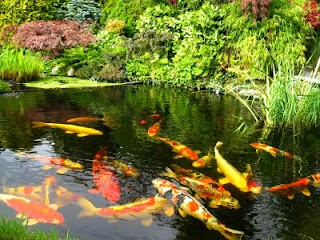
Unleashing the Beauty of Grey Water Koi Pond: A Sustainable and Serene Oasis
Unleashing the Beauty of Grey Water Koi Pond: A Sustainable and Serene Oasis
Imagine stepping into your backyard and being greeted by the sight of elegant Koi gracefully swimming in crystal clear water, surrounded by vibrant aquatic plants. If this sounds like a scene from your dreams, a Grey Water Koi Pond might be the perfect addition to your home. In this article, we will delve into the captivating world of Grey Water Koi Ponds, exploring their ecological benefits, design considerations, and maintenance practices. So, let’s dive in!
What is a Grey Water Koi Pond?
A Grey Water Koi Pond, also known as a Sustainable Koi Pond, is a unique landscaping feature that utilizes recycled water from your household to sustain an eco-friendly and self-sufficient aquatic environment. Grey water refers to domestic wastewater generated from activities like washing machines, showers, and sinks. Instead of letting this water go to waste, it is directed towards the Koi pond, providing a constant supply of fresh water for the Koi and supporting the overall ecosystem.
Not only does a Grey Water Koi Pond reduce the strain on fresh water resources, but it also minimizes your environmental footprint by promoting water conservation. By harnessing the potential of grey water in your backyard oasis, you can contribute to sustainable gardening practices and create a mesmerizing sanctuary for both yourself and your finned friends.
Design Considerations for a Grey Water Koi Pond
Creating a visually stunning and functional Grey Water Koi Pond requires careful planning and consideration of various elements. Here are some crucial design considerations to take into account:
1. Pond Size and Depth
The size and depth of the pond play a vital role in ensuring a healthy and thriving aquatic ecosystem. While Koi are beautiful and sociable creatures, they require ample space to swim and grow. A pond that is too small can cause stress and hinder their well-being. The average depth of a Grey Water Koi Pond ranges from 4 to 6 feet, providing adequate space for the Koi to thrive.

2. Filtration System
An effective filtration system is essential for maintaining water quality and clarity in a Grey Water Koi Pond. Since the pond relies on recycled water, proper filtration ensures that contaminants and impurities are removed, providing a healthy habitat for the Koi and aquatic plants. Consider incorporating a multi-stage filtration system, including mechanical, biological, and chemical filtration, to maintain optimal water conditions.
3. Water Circulation and Aeration
Proper water circulation and aeration are vital for Koi ponds. An efficient water pump will help keep the water moving, preventing stagnation and oxygen depletion. Additionally, aeration devices such as air stones or waterfalls provide much-needed oxygen to the pond, ensuring the well-being of both the Koi and other aquatic inhabitants.

4. Plant Selection
Aquatic plants not only enhance the visual appeal of a Grey Water Koi Pond but also serve as natural filters, helping to remove excess nutrients from the water. When selecting plants, opt for a variety that can thrive in both submerged and emergent conditions. Consider including water lilies, lotus, and submerged plants like hornwort or waterweed to provide shade, oxygenate the water, and create a harmonious ecosystem.
Maintenance Practices for a Grey Water Koi Pond
To ensure your Grey Water Koi Pond remains a scenic and sustainable oasis, regular maintenance is essential. Here are a few maintenance practices to keep in mind:
1. Water Testing and Quality Control
Regularly test the water parameters such as pH, ammonia, nitrite, and nitrate levels to maintain optimal water quality. Implement appropriate measures like water changes, beneficial bacteria supplementation, and algae control methods to prevent imbalances and ensure a healthy environment for your Koi.

2. Debris Management
Removing debris like fallen leaves, algae, and excess fish food from the pond is crucial to prevent water contamination and maintain clarity. Use a pond skimmer, net, or other appropriate tools to regularly clean out any unwanted debris. Remember to dispose of the debris properly and consider composting organic materials.
3. Equipment Maintenance
Check and maintain your filtration system, water pump, and aeration devices regularly. Clean or replace the filter media as needed and ensure that pumps and other equipment are functioning optimally. Regular maintenance will help prolong the lifespan of your equipment and ensure the efficient operation of your Grey Water Koi Pond.

Embrace the Charms of a Grey Water Koi Pond
Incorporating a Grey Water Koi Pond into your landscape not only provides a breathtaking focal point but also showcases your commitment to sustainable living. By repurposing and replenishing grey water, you can create a stunning habitat for Koi and other aquatic life while minimizing water wastage. Embrace the uniqueness of a Grey Water Koi Pond and indulge in the tranquil serenity it offers!